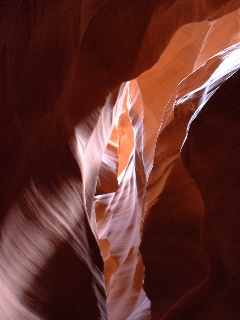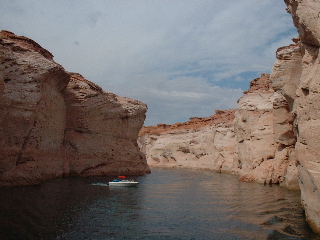
Ken and Nieka in Antelope Canyon.

Antelope Canyon near Page, Arizona.
Day-by-Day |
|
| Introduction | |
| Travel | |
| Zion National Park | |
| Bryce National Park | |
| Zion National Park | |
| Coral Pink Dunes, Cedar Breaks and the Vermilion Cliffs | |
| Grand Canyon North Rim | |
| Antelope Canyon and Lake Powell | |
| Navajo National Monument, Monument Valley, and Natural Bridges | |
| Arches National Park | |
| Canyonlands National Park | |
| Arches and the Drive to Park City | |
| Utah Olympic Park | |
| Park City and Olympic Cauldron Park | |
Other Links |
|
| 2002 Winter Olympics | |
| 2001 Europe | |
| 1999 Australia | |
| Home Page | |


Today was a more relaxed day. We started off the day by taking a guided tour to Antelope Canyon, a slot canyon about 20 minutes' drive from downtown Page. The canyon is located on Navajo land, and was only discovered around 1930. We rode the few miles to the canyon in an off-road pickup truck, first on the highway, and then on a dry wash that leads to the canyon's exit. Antelope Canyon is between eight and four feet wide and presently about 25-40 feet deep. It has been carved by flash floods out of Navajo sandstone and winds its way a few hundred feet through a rock formation. The twists and turns of the canyon -- and the sculptures the periodically raging flood waters have left -- are testament to the power of water over rock. In several places, cedar tree trunks are lodged between protrusions 15 feet over the sandy floor of the canyon -- left there during the last flash flood some five years ago. The nearest cedar trees upstream are, we were told, 30 miles away.
After lunch at RD's Drive-In, we set off for our afternoon adventure -- a cruise on Lake Powell to Navajo and Antelope Canyons. The cruise itself was quite pleasant, but we had mixed feelings about the trip. The Glen Canyon Dam, which creates Lake Powell, flooded almost 200 miles of the canyon. At the parts of the canyon we visited, within a few miles of the dam, the water is as much as 500 feet deep.

Having visited spectacular canyons (the Grand Canyon and Zion Canyon), we felt a certain sadness about the landscapes that were flooded below the boat. And since the dam was engineered so well, it will likely outlast the canyon walls around it -- perhaps making, one day in the distant future, an island in the once-again flowing Colorado.